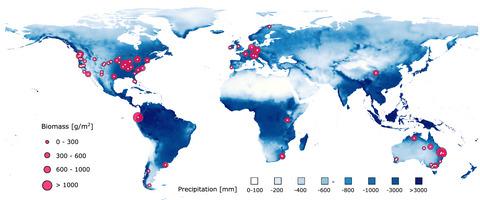当前位置:
X-MOL 学术
›
Ecol. Lett.
›
论文详情
Our official English website, www.x-mol.net, welcomes your
feedback! (Note: you will need to create a separate account there.)
Soil properties as key predictors of global grassland production: Have we overlooked micronutrients?
Ecology Letters ( IF 7.6 ) Pub Date : 2021-10-06 , DOI: 10.1111/ele.13894 Dajana Radujković 1 , Erik Verbruggen 1 , Eric W Seabloom 2 , Michael Bahn 3 , Lori A Biederman 4 , Elizabeth T Borer 2 , Elizabeth H Boughton 5 , Jane A Catford 6 , Matteo Campioli 1 , Ian Donohue 7 , Anne Ebeling 8 , Anu Eskelinen 9, 10, 11 , Philip A Fay 12 , Amandine Hansart 13 , Johannes M H Knops 14 , Andrew S MacDougall 15 , Timothy Ohlert 16 , Harry Olde Venterink 17 , Xavier Raynaud 18 , Anita C Risch 19 , Christiane Roscher 9, 10 , Martin Schütz 19 , Maria Lucia Silveira 20 , Carly J Stevens 21 , Kevin Van Sundert 1 , Risto Virtanen 11 , Glenda M Wardle 22 , Peter D Wragg 2 , Sara Vicca 1
Ecology Letters ( IF 7.6 ) Pub Date : 2021-10-06 , DOI: 10.1111/ele.13894 Dajana Radujković 1 , Erik Verbruggen 1 , Eric W Seabloom 2 , Michael Bahn 3 , Lori A Biederman 4 , Elizabeth T Borer 2 , Elizabeth H Boughton 5 , Jane A Catford 6 , Matteo Campioli 1 , Ian Donohue 7 , Anne Ebeling 8 , Anu Eskelinen 9, 10, 11 , Philip A Fay 12 , Amandine Hansart 13 , Johannes M H Knops 14 , Andrew S MacDougall 15 , Timothy Ohlert 16 , Harry Olde Venterink 17 , Xavier Raynaud 18 , Anita C Risch 19 , Christiane Roscher 9, 10 , Martin Schütz 19 , Maria Lucia Silveira 20 , Carly J Stevens 21 , Kevin Van Sundert 1 , Risto Virtanen 11 , Glenda M Wardle 22 , Peter D Wragg 2 , Sara Vicca 1
Affiliation

|
Fertilisation experiments have demonstrated that nutrient availability is a key determinant of biomass production and carbon sequestration in grasslands. However, the influence of nutrients in explaining spatial variation in grassland biomass production has rarely been assessed. Using a global dataset comprising 72 sites on six continents, we investigated which of 16 soil factors that shape nutrient availability associate most strongly with variation in grassland aboveground biomass. Climate and N deposition were also considered. Based on theory-driven structural equation modelling, we found that soil micronutrients (particularly Zn and Fe) were important predictors of biomass and, together with soil physicochemical properties and C:N, they explained more unique variation (32%) than climate and N deposition (24%). However, the association between micronutrients and biomass was absent in grasslands limited by NP. These results highlight soil properties as key predictors of global grassland biomass production and point to serial co-limitation by NP and micronutrients.
中文翻译:

土壤特性作为全球草地生产的关键预测因素:我们是否忽视了微量营养素?
施肥实验表明,养分有效性是草地生物量生产和碳固存的关键决定因素。然而,很少有人评估养分对解释草地生物量生产空间变异的影响。使用包含六大洲 72 个地点的全球数据集,我们调查了影响养分有效性的 16 个土壤因素中,哪些与草地地上生物量的变化最密切相关。还考虑了气候和 N 沉积。基于理论驱动的结构方程模型,我们发现土壤微量营养素(尤其是锌和铁)是生物量的重要预测因子,与土壤理化性质和 C:N 一起,它们解释了比气候和 N 更独特的变化(32%)沉积(24%)。然而,在受 NP 限制的草地中,微量营养素和生物量之间不存在关联。这些结果强调土壤特性是全球草地生物量生产的关键预测因子,并指出 NP 和微量营养素的连续共同限制。
更新日期:2021-11-11
中文翻译:

土壤特性作为全球草地生产的关键预测因素:我们是否忽视了微量营养素?
施肥实验表明,养分有效性是草地生物量生产和碳固存的关键决定因素。然而,很少有人评估养分对解释草地生物量生产空间变异的影响。使用包含六大洲 72 个地点的全球数据集,我们调查了影响养分有效性的 16 个土壤因素中,哪些与草地地上生物量的变化最密切相关。还考虑了气候和 N 沉积。基于理论驱动的结构方程模型,我们发现土壤微量营养素(尤其是锌和铁)是生物量的重要预测因子,与土壤理化性质和 C:N 一起,它们解释了比气候和 N 更独特的变化(32%)沉积(24%)。然而,在受 NP 限制的草地中,微量营养素和生物量之间不存在关联。这些结果强调土壤特性是全球草地生物量生产的关键预测因子,并指出 NP 和微量营养素的连续共同限制。







































 京公网安备 11010802027423号
京公网安备 11010802027423号